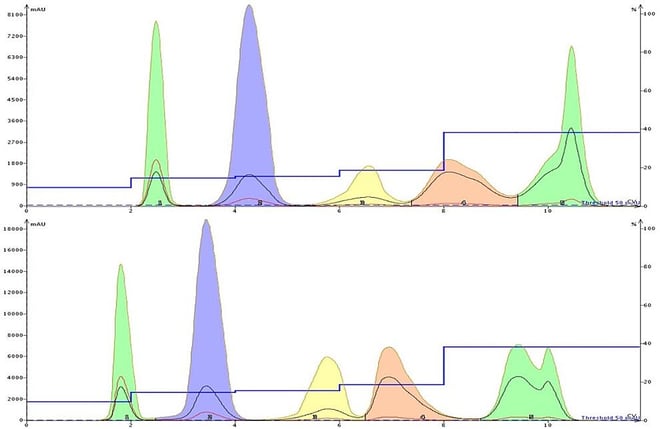The evolution of flash column chromatography has brought chemists many new and exciting options for crude mixture purification. Among them are so-called high-performance flash columns or cartridges. These high-performance purification tools are typically filled with silica or other media 15 to 30 microns in particle diameter (versus 40-63 micron for standard flash media) and provide the expectation of better separations and higher purity fractions. That’s really enticing but how often do you need these types of columns especially since they are, of course, more expensive? Well, that question is what I address below.
Flash purification, aka flash chromatography, is an off-shoot of organic synthesis. It is an integral part of most synthetic or natural product workflows. As such, it requires goal setting just as your synthesis project does. How much final product do I need? How pure does it need to be? How fast do I need to develop my synthesis methodology? Will this need scale-up? These questions also apply to your purification.
From my perspective, if you are creating or isolating a new molecule it is because it has never been synthesized or it is too expensive to purchase. That being the case then, the compound you are making (including intermediates) or isolating is likely more valuable than any of the reagents and tools you are using – including your flash column. So, doesn’t it make sense to use the best tool for the job especially if the flash column will provide you with a higher purity compound/intermediate? Why throw away more valuable material that does not meet your purity threshold than you need to?
But does that mean you always need to use high-performance flash columns? No. If your separation is easy with a large delta CV (ΔCV) between your targeted compound and its nearest eluting neighbors, then a standard particle size media cartridge is fine. However, that situation is rare and complicated with the desire by most researchers to reduce solvent consumption. The latter can often be addressed by using the high-performance flash column. Loading capacity on these superior materials can be 2 to 4 times higher than the standard grade media. This means smaller column sizes using much less solvent (and less time) can be used effectively without purity sacrifice, Figure 1.
 Figure 1. Purification performance comparison between a standard 40-63 micron silica, 25 gram flash column (top) and a high-performance 25 micron silica, 10 gram column (bottom). The amount of crude material loaded was 400 mg on each column. The high-performance column (bottom) provided a better separation with 60% less silica than the standard silica column and consumed 50% less solvent.
Figure 1. Purification performance comparison between a standard 40-63 micron silica, 25 gram flash column (top) and a high-performance 25 micron silica, 10 gram column (bottom). The amount of crude material loaded was 400 mg on each column. The high-performance column (bottom) provided a better separation with 60% less silica than the standard silica column and consumed 50% less solvent.
If you invest in your research wisely, including high-performance purification columns, you will surely be rewarded with higher purity final compounds and lower purification costs.
For more information on the benefits of high-performance flash columns read the following blog article:

 Organic Workflow
Organic Workflow Peptide Workflow
Peptide Workflow Scale-Up Flash Purification
Scale-Up Flash Purification  Sample Preparation
Sample Preparation Biomolecule Purification
Biomolecule Purification Oligo synthesis
Oligo synthesis Scavengers and Reagents
Scavengers and Reagents Service & Support
Service & Support Accessories & Spare parts
Accessories & Spare parts Investors
Investors Reports & News
Reports & News The Share
The Share Corporate Governance
Corporate Governance Calendar
Calendar Sustainability
Sustainability Our Offering
Our Offering Our History
Our History Our Locations
Our Locations Leadership
Leadership